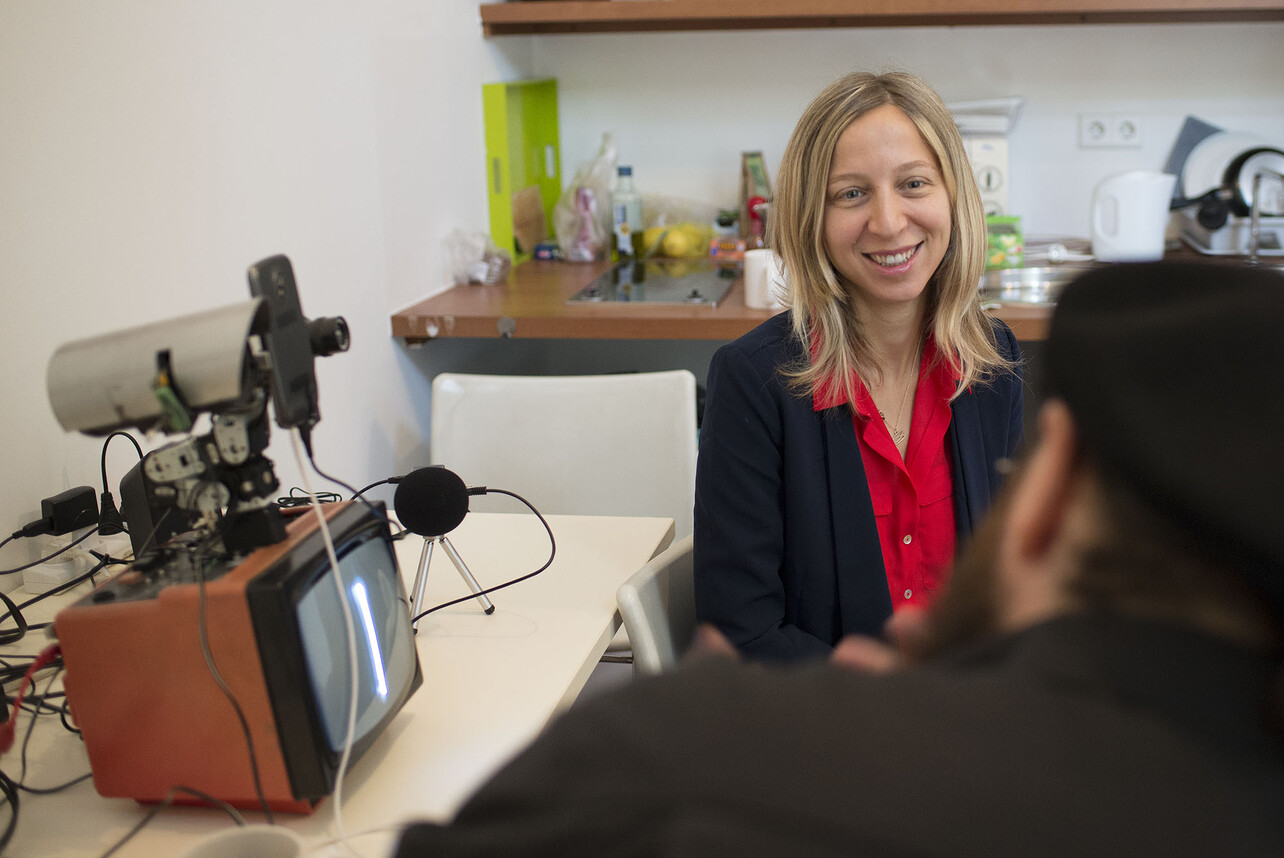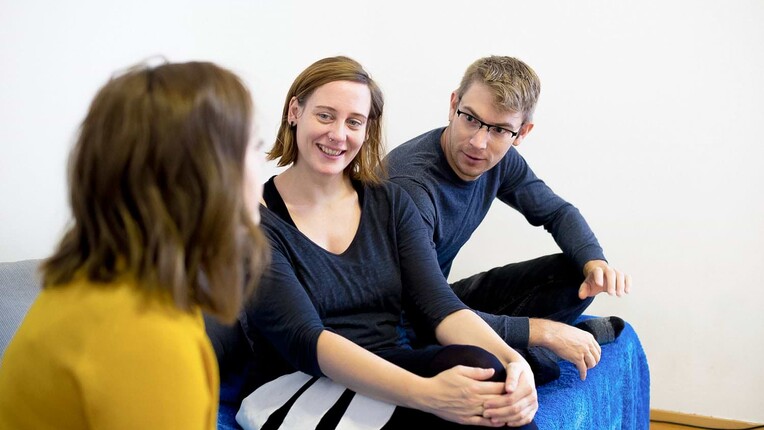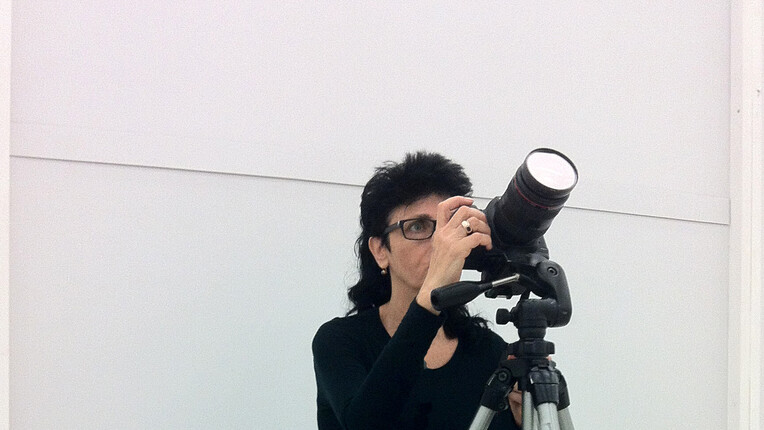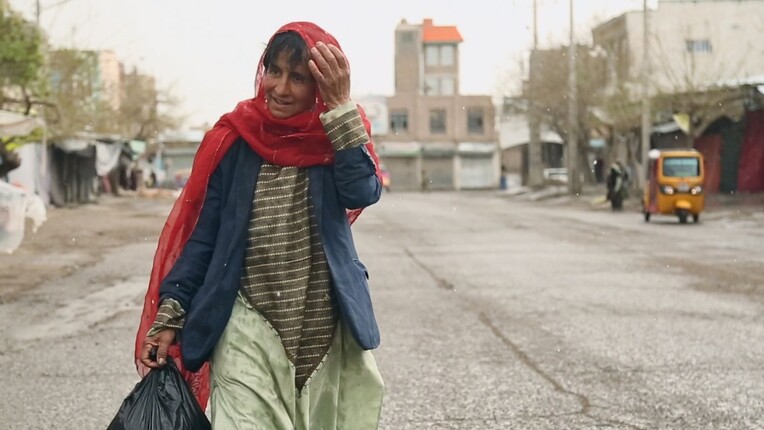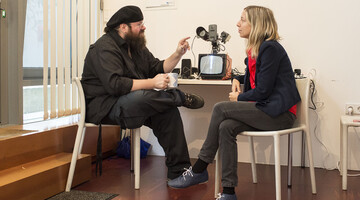
"Frankie’s name is a reference to frankness"
Maayan Sheleff (ISR), Artist-in-Residence at quartier21/MQ was invited for the current festival for digital art and culture, “paraflows”, with her project Frankie.
Maayan Sheleff (ISR), Artist-in-Residence at quartier21/MQ was invited for the current festival for digital art and culture, “paraflows”, with her project Frankie. Frankie the Documentary Robot is an experimental research project on the human-machine- relationship, authorship and surveillance, involving a robot that interviews people and documents them, forming an online archive. Frankie was developed at Artport residency, Tel- Aviv, and participated in Ars Electronica festival, Austria, in the frame of Ars Campus exhibition.
One of the “paraflows”-curators, Günther Friesinger (monochrom), interviewed Maayan.
Could you tell us about your work and what inspires you?
I work mostly as a curator, although sometimes my practice is somewhat experimental so you could call it an art work. I don’t try to define it too much, but I do like creating context from other people’s creations, which is, I guess, what a curator does.
My projects often deal with the human experience, whether it’s through exploring human- machine relationship, or documentary practices that invoke testimony and trauma. I’m also interested in collaborative practices, such as artists who work with communities or create interventions and interactions that respond to social and political situations.
I’m inspired by honesty, compassion, nuances and complexities, and art which is both intellectually invigorating and emotionally touching, particularly if it’s layered and not easily comprehended- like there is some mystery or magic behind it.
Which digital media is important for you as an artist?
As an artist and as a curator, the media is less important to me than the context. The media is just a tool, and I think it’s important to remember this when creating digital art or new media. I do find reflexivity an important tool though, so when an artwork responds to the media and addresses it in a critical way, it usually says something not only about the media, but about how we humans use it and how it uses us in our every day life. I think we are at an interesting and pivotal point in the art discourse regarding new media- after years of being discovered and experimented with, as a relatively new tool, we are finally seeing deep, contemplative artworks and serious academic research about these practices, so it can develop in interesting ways.
Do you see art as the most relevant way for critical actions?
I think art is a unique way of critical action because it enables a more poetic and open criticality, one that is political in a wide sense but that often manages to avoid being recruited for a specific rigid political agenda. But as a curator who works often with political and activist art I sometimes wonder about art’s ability to actually create change. Perhaps because of its layered, at times abstract character, it can fail to impact reality in a true sense. But it does have the ability to shift people’s perspective, and I think that the most relevant and potent forms of critical artistic actions are the ones that are combined with other types of political or activist practices. Of course today the borders are quite blurred.
To which media theoreticians do you refer in your practice?
It changes according the project I’m working on, and often it’s not necessarily media theoreticians that I refer to. For example, Frankie the robot is the result of research done for two different exhibitions I curated- one was “Prolonged Exposure” at the CCA Tel Aviv, dealing with trauma and testimony. I was researching experimental documentary practices and was specifically interested in texts about trauma, testimony and its manifestation in art, so Susan Sontag, Cathy Caruth and Shoshana Felman and Dori Laub were some of the theoreticians I was studying.
The other exhibition was “Other Lives” at the Science Museum in Jerusalem, and it was inspired by the life and practice of Alan Turing, so I looked into many of his researches regarding artificial intelligence. In my most recent exhibition, “The infiltrators” at Artport Gallery in Tel Aviv, I looked into the relation between ethics and esthetics in participatory art practices, and included a text by Claire Bishop, whose work in this field I deeply relate to and appreciate.
Who or what exactly is Frankie?
Frankie is a documentarian robot that interviews people, attempting to “learn” what it means to be human. The videos, filmed by Frankie’s surveillance- camera eyes, are later uploaded to a website which forms an archive of the robot’s research: www.frankieproject.com
Frankie responds to words that it recognizes both with language and “eye/camera” movements.
Technically, it’s controlled by an android application, installed on a mobile phone and utilizing capabilities such as face detection, voice recognition and text-to-speech. Frankie’s algorithm enables it to voice a question, listen to the answer, analyze it and determine a following question. Frankie’s decision making is based on the context of the conversation, key phrases and key words, that may also cause Frankie’s “eyes” and “neck” to move, attempting to mirror the feelings expressed by the interviewee. The movement, a choreography of 5 joints, each of them having a Dynamixel AX-12A servo, is generated via a IOIO device, that connects the Android to the motors through an Arduino microcontroller.
What is the goal of the project?
As a form of “automatic” documentation that allegedly excludes the artist’s authorship, Frankie questions notions of representation and participation, as well as issues such as agency, control, and privacy, questioning how they affect us in a world in which every second is documented and mediated. It reflects upon the manner in which we choose to perform and present ourselves in the digital age, and how this ultra narcissistic world affects our perception of the other.
Which historical background concerning the relationship of art and technology like ELIZA is important for your project?
As you mentioned, Frankie does reference ELIZA, the first 70s Chat Bot that was designed to resemble a psychoanalyst, and questions the “ELIZA effect” – a phenomenon which causes people to treat an artificial being like a human being.
Frankie’s name is a reference to frankness – honesty, directness – but also to Frankenstein – the well known myth on the hubris of creation. I sort of see Frankenstein as the first important story about the relationship of humans, technology and creation (which of course came from the myth of the “Golem”, which was less technological as it was made of dirt…). The story of Frankenstein is also related to that idea of “Otherness” I spoke about- the creature was hated and feared for being different, even though he was kind of nice. Eventually he became a monster because this is what people expected of him.
Interestingly, Alan Turing, the famous British mathematician and philosopher who between the 1930′s-1950′s invented what is now considerd as the first computer, thought of machines as “others” which are mistreated and misunderstood (This was also related to the fact that he was gay and prosecuted for that). He believed that one day machines could think, and so created the Turing test, which tests whether the interviewee is a human or a machine. If the interviewee convinced the interrogator that he is human, that means that he passed the test. Until today variations on this text are used on chat bots, similar to Frankie. But Frankie is actually a reverse Turing test- since she admits that she is still learning to be human, with all the flaws that come with it, she challenges the poeple to show how human they actually are.
Interview: Günther Friesinger
